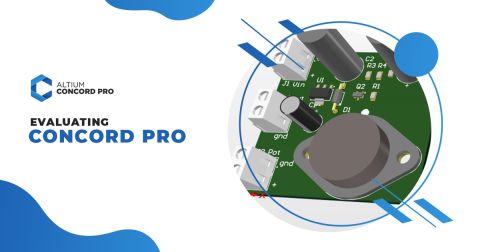Data Management for Component Models in SPICE PCB Simulations

Simulation software is becoming more powerful as time goes on, but the simplest solutions are sometimes still preferable for many applications. SPICE simulations have been around for decades, yet their applicability to a wide variety of circuits and applications is not lost on anyone. With SPICE simulation tools being so popular, it’s only natural that they appear in PCB design software platforms.
Devices continue to become more powerful and more complicated, yet SPICE simulations still have a fundamental role to play in the PCB design process. One important design aspect is the use of SPICE simulations for analog circuit design, transient analysis, and small signal analysis.
Something that is often overlooked is the accuracy of SPICE simulations as this depends on having accurate SPICE models. With the right design data management platform, you’ll have instant access to component model updates and you can quickly import these updates into your schematics. Altium Concord Pro provides you with the tools you need to quickly access the SPICE models you need and immediately update your design data, and all within Altium Designer.
ALTIUM CONCORD PRO®
Altium Concord Pro™ as a standalone product and brand name has been discontinued and the capabilities are now available as part of our Altium enterprise solutions. Learn more here.
A unified data management solution that integrates with the design and simulation features in Altium Designer®.
These days, PCB design is about much more than just arranging components on a bare substrate. In days past, when digital signals switched slow enough that they did not suffer signal integrity problems and when analog devices operated at lower frequencies, most boards required simpler design considerations. You could large arrange your components while only worrying about board size and form factor, and most designers could rest assured that their boards would work properly.
With new technology comes more advanced design requirements, and you’ll need more than just CAD tools for PCB designs. Signal integrity is now an important consideration for any modern device, and your design data needs to integrate with simulation and verification tools in order to ensure your board functions as desired. Simulations can also be used as part of your design workflow in order to design and lay out a variety of circuits.
Your component data and layout play a major role in verifying your design with your PCB design tools. When you work with PCB design software that operates on a unified data model, your components will include circuit models that can be quickly used in SPICE circuit simulations. You shouldn’t have to rebuild your schematic in a separate simulation program or export data between programs in the same platform. Instead, you can access SPICE simulations at the click of a button with Altium Designer and Altium Concord Pro.
Benefits of Using a SPICE Simulation in PCB Design
When it comes to circuit board design, you’ll need to perform a number of analyses to ensure that your device will function as you envision. Your schematic form the blueprint of your design, but they also form the foundation for any circuit simulation you need to perform. The best PCB design software platforms will include SPICE circuit simulation capabilities for any linear circuit. This includes transient analysis with arbitrary switching waveforms and AC/DC sweeps. With nonlinear circuits, you’ll need to perform small signal analysis to examine the behavior at different AC or DC driving voltages when performing sweeps with your simulator.
Using a SPICE-based circuit simulator (e.g., HSPICE, LTSPICE, PSpice, and others) is extremely useful during schematic design as this can help you make important design decisions before you layout your board. If you end up waiting until your design is finished to run a circuit simulator, you may find yourself in the position where a significant portion of your layout needs to change. Checking that your circuit meets your design requirements with a simulator allows you to identify signal problems before you layout board and make changes as necessary.
Examples of SPICE Simulations in PCB Design
Some common circuit simulation techniques are extremely useful for verifying circuit functionality. These can be divided into frequency domain and time domain simulations, although SPICE frequency domain simulations are typically only useful with sinusoidal drivers. In the digital domain, transient analysis is very important for identifying a number of signal integrity problems that plague many devices, including ringing, overshoot/undershoot, and termination design.
In the analog domain, frequency sweep simulations are extremely important for filter and analog amplifier design. Any filter or amplifier circuit can modify an input AC signal, producing an output that is shifted in time and with different amplitude. You can also include active and nonlinear circuits in your device for use in AC analysis. A SPICE simulator will allow you to examine how the shape of your input waveform changes as it passes through these elements, and you’ll have a better idea of the limits and capabilities of your device.
These simulations take data from electronic circuits in your schematic and generate a linear simulation that can be solved with the Gauss-Jordan method, which forms the cornerstone of any SPICE simulation. This is where component data that includes SPICE models becomes important as this data will be input directly to your simulator for further analysis.
- SPICE remains a popular foundation for circuit simulation and verification and is built into most PCB design platforms.
Learn more about adapting a SPICE simulator to your PCB design workflow.
- High-speed designs carry a number of constraints on functionality and performance. You can address all these important points with a SPICE simulator.
Learn more about the value of a SPICE simulator in high-speed PCB design.
- Power PCB design software will include the tools you need to import SPICE models as part of your proprietary component data and include this data in a circuit simulation.
Learn more about working with SPICE models in Altium Designer.

SPICE simulation output in Altium Designer
Avoid Redesigns with SPICE Simulations
Anytime you layout a board before verifying its functionality, you put yourself at risk of a redesign. The best time to start verifying the functionality of your board is after completing the first draft of your schematic. You’ll want to analyze issues like transient response changes in a DC voltage or to streams of digital pulses, as well as attenuation and phase shifting of analog signals. Signal integrity is of paramount importance in any modern PCB, and your simulations should try to assess this important design aspect.
When preparing a SPICE model in your PCB design software, you’ll need to make sure that the SPICE models for your components are up to date and that your components have not gone obsolete. Components are periodically updated, and you’ll need to keep the newest versions of electrical models for your components in your schematic.
Keeping Your SPICE Models Updated
Obsolescence is an important point to consider during the design phase. You’ll need to make sure that the components you include in your design are sourceable and that the data for your component models and footprints are up to date. The right PCB design software will help you address these issues with obsolescence and sourcing without forcing you to scan distributor websites or work with a 3rd party application.
A platform that offers full unification of PCB design tools with data management and simulation tools allows you to take your component data and bring it into your schematics and bills of materials. A data management platform that is integrated within your PCB design software will help you keep your SPICE models for your components updated and will pass this data directly to your schematic and layout.
-
Learn more about accessing sourcing information in your PCB design software.
- Smaller service bureaus and huge electronics companies can all benefit from a managed supply chain visibility solution.
- Keeping up with design data updates helps you stay current with industry standards, including IPC standards.
Learn more about keeping up with design standards while preparing for manufacturing.

Updated sourcing and footprint information in Altium Concord Pro
SPICE Simulation and Data Management in a Unified Environment
Altium Designer provides you with a full suite of design tools that have helped set the standard in the PCB design industry. This includes a set of simulation tools that are built around SPICE and even accommodate PSpice models. This allows you to execute digital, analog, and mixed simulations directly from a single program. Your schematic data is brought into your simulations are your signal integrity results are displayed in an intuitive format.
Improve Management and Simulation with Altium Concord Pro
Altium Concord Pro was built to complement the data management capabilities that already exist in Altium Designer. The suite of data management features in Altium Concord Pro will import component model updates into your libraries and will provide you with sourcing updates in a single environment. You won’t have to use a 3rd party service or manually search for component updates with Altium Concord Pro.
- Altium Designer’s unified environment is built on top of a rules-driven design engine that provides full integration of your design tools. You can now expand the capabilities of Altium Designer with Altium Concord Pro, giving you access to a complete data management solution in a single program.
Learn more about Altium Designer’s unified design environment.
- Altium Concord Pro is the only data management tool that integrates with Altium Designer and provides full integration with popular mechanical design programs. Component data updates will immediately pass to your PCB libraries with Altium Concord Pro.
Learn more about integrating Altium Designer and Altium Concord Pro.
- Altium Concord Pro passes the component data updates you need for SPICE simulations directly to your library and helps you keep your designs current.

You can attach simulations to components in your Altium Concord Pro database.
As a radical innovator in the PCB design industry, Altium provides you with the resources you need to keep up with the pace of new technology. Other ECAD platforms offer little to no data management support, and those that do cannot automatically pass this data into your schematics, layout, and simulations. These other platforms force you to import data updates manually, which hampers your productivity instead of improving it. Altium takes design unification to the next level with Altium Concord Pro, the only data management solution that synchronizes all aspects of design, supply chain management, and simulation.
Now you can expand the top-notch capabilities in Altium Designer with the data management features in Altium Concord Pro. When your PCB design and simulation features are integrated in a single platform, you can work at peak productivity and you can synchronize updates to your design data and libraries at the click of a button. Now is the time to ditch other data management and simulation platforms and make the switch to Altium Designer and Altium Concord Pro.










